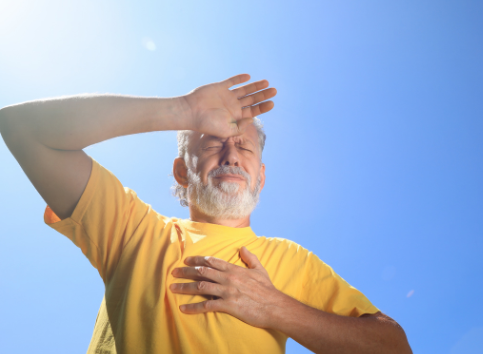Heatstroke: How to recognize and treat it?
Published Jul 1, 2024 • By Sahar Haidar
When the body is unable to regulate its internal temperature due to intense and prolonged heat exposure, it is referred to as heatstroke. This condition is often caused by excessive sun exposure, especially during heatwaves or periods of extreme heat.
How to react in case of heatstroke? What are the causes? How to treat it?
We cover everything in our article!

What is heatstroke?
Heatstroke refers to a range of disorders that occur during prolonged exposure to the sun's rays. Normally, the human body regulates internal temperature to keep it around 37°C. Sun exposure causes an increase in the temperature of the head and then the body (hyperthermia), which impairs the body's ability to regulate its temperature. Mechanisms such as sweating are no longer able to keep the body temperature around 37°C.
Heatstroke can last for several hours after exposure. Depending on the duration and intensity of sun exposure, as well as the age and health status of the person, heatstroke can last for a day or two.
What causes heatstroke?
The primary causes of heatstroke are prolonged exposure to the sun, especially during the hottest hours of the day. Dehydration is also a major cause; not drinking enough water can exacerbate the effects of sun exposure. Finally, lack of protection, such as not wearing a hat, light clothing, or sunscreen, can increase the risk.
Who is at risk?
Anyone can be affected by heatstroke. However, vulnerable individuals are more sensitive to sun exposure, including babies and children, outdoor workers, athletes practicing outdoors, the elderly, and people with disabilities or chronic illnesses (diabetes, respiratory or cardiac insufficiency, etc.).
What are the signs and symptoms of heatstroke?
Symptoms can vary from person to person based on factors such as age, general health, and duration of heat exposure. Common signs and symptoms include:
- Increased body temperature: An internal temperature exceeding 40°C.
- Heatstroke: Feeling intensely hot.
- Red skin: Due to the dilation of blood vessels in response to heat.
- Excessive sweating: Trying to regulate body temperature.
- Headaches: Often intense and accompanied by dizziness.
- Fatigue and weakness: General exhaustion.
- Confusion and dizziness: Difficulty concentrating and feeling light-headed.
- Muscle cramps: Often due to dehydration.
- Increased heart rate: Rapid and irregular heartbeats.
- Nausea and vomiting: Feeling unwell.
- Gastrointestinal issues: Such as diarrhea.
How is heatstroke diagnosed?
Doctors can diagnose heatstroke through clinical signs. They may also request blood tests or urine analyses to check kidney function.
How to treat heatstroke?
Heatstroke should never be ignored as it can be serious and requires immediate attention to avoid complications. Treatment can involve several steps:
- Cooling the body: Moving to a cool, shaded place, applying cold compresses, or taking a cold shower.
- Hydration: Drinking water or electrolyte drinks to replace lost fluids.
- Rest: Lying down and resting to allow the body to recover.
- Medical supervision: If symptoms are severe, it's crucial to consult a doctor or go to the emergency room.
- In severe cases, hospitalization may be necessary for intravenous rehydration.
Tips to prevent heatstroke
Avoid prolonged sun exposure. Protective measures include:
- Hydrating sufficiently: Regularly offering water, especially to children.
- Appropriate clothing: Wearing light clothes and a hat.
- Avoiding the hottest hours: Limiting sun exposure during the hottest parts of the day.
- Using sun protection: Applying broad-spectrum sunscreen with a high protection factor.
- Avoiding naps in the sun.
- Avoiding alcohol consumption before or during sun exposure.
Heatstroke and heatwaves
Heat-related deaths in the U.S. have been increasing. In 2022, there were 1,714 reported deaths due to heat, according to the CDC. Other studies suggest the actual number could be higher, estimating between 1,300 to 5,608 deaths annually.
Was this article helpful to you?
Give it a "Like" and share your thoughts and questions with the community in the comments below!
Take care!
Sources :
Asmara IGY. Diagnosis and Management of Heatstroke. Acta Med Indones. 2020 Jan;52(1):90-97. PMID: 32291378.
Hifumi T, Kondo Y, Shimizu K, Miyake Y. Heat stroke. J Intensive Care. 2018 May 22;6:30. doi: 10.1186/s40560-018-0298-4. PMID: 29850022; PMCID: PMC5964884.
Fortes chaleurs et canicule : un impact sur la mortalité important nécessitant le renforcement de la prévention et de l’adaptation au changement climatique, Santé Publique France
How many people die from extreme heat in the US? — USA Facts
Joe Biden said heat kills more Americans than floods, hurricanes, and tornadoes combined. Is it true? — PolitiFact
Extreme Heat — US Department of Health and Human Services
Comments
You will also like

Spoon theory: What is it and how can it help people living with chronic illness?
Apr 13, 2022 • 7 comments

What is the psychological impact of chronic pain? Carenity members share their experience!
May 27, 2021 • 8 comments

 Facebook
Facebook Twitter
Twitter
